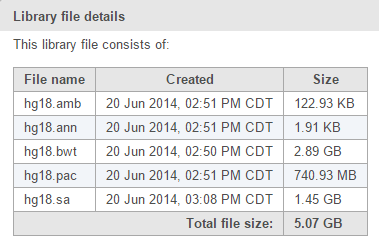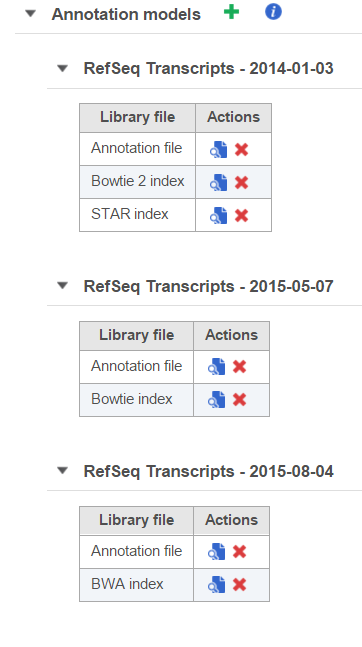Page History
The library files associated with the selected assembly are organized into six major sections.
Below is some information on each section. For more detail on adding library files, see the Adding library files to an assembly on the library file management page section of this user guide.
...
Reference aligner indexes. Next-generation sequencing aligners require the reference sequence to be indexed prior to alignment, as this greatly increases alignment speed. An index consists of a set of files (Figure 61) and are generally aligner specific. For example, if you wish to align using BWA, you need a BWA index.
...
Annotation models will appear in separate tables (Figure 72). If you have multiple versions of annotation models from the same source, it is advisable to distinguish them by their date or version number.
Annotation models from commonly used sources (e.g. Refseq, ENSEMBL) are available for automatic download from the Partek repository. Because annotation models are frequently updated, these sources are checked for updates quarterly. You can check for recent updates to the Partek repository on the Partek website.
Annotation models are used for quantification in gene expression analyses, annotating detected variants (e.g. to predict amino acid changes), visualizations in Chromosome view, generating coverage reports and for aligner index creation (see Adding Aligner Indexes Based on an Annotation Model). Typical file formats include GTF, GFF, GFF3 and BED.
The gray arrows (/) next to the annotation model name expand/collapse each table. The three annotation models displayed in Figure 7 2 are different versions from the same source (RefSeq), distinguishable by their date. Aligner indexes (e.g. for alignment to the transcriptome) are added to the table of the corresponding annotation model.
...
The aligner indexes in the Annotation models section are required if you wish to align to a subset of the genome as defined by the annotation model, e.g. target amplicons or the transcriptome. The reference sequence is still required to generate an aligner index for an annotation model. As with whole genome alignment, indexes are aligner specific, although some aligners share indexes and are version specific (see Reference aligner indexes). The aligner indexes generated will be added to the corresponding annotation model table (Figure 72).
| Additional assistance |
|---|
|
...

